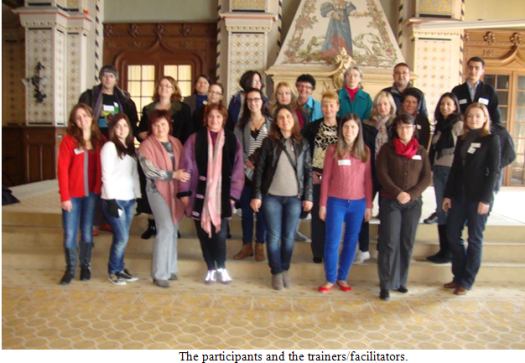Dissemination of Grundtvig workshop "Empowering Women's Leadership within Civil Society", Caux, Switzerland, 2013
Nicoleta Cibu, Romania

Nicoleta Cibu is an EFL Teacher in Liceul Tehnologic Sebeş, Romania.
E-mail: nicoleta.cibu@gmail.com

Between the 1st and 5thof April 2013, took place the Grundtvig workshop "Empowering Women's Leadership within Civil Society", sponsored by Grundtvig Switzerland, Life Long Learning Programme. The empowering workshop was held at and organized by Caux-Initiatives of Change, (www.iof.org) Evi Lichtblau as Coordinator, in partnership with Institute of Cultural Affairs, Spain (www.iac-es.org) which was in charge of the content, process and learning outcomes of the workshop, by the highly competent ICA Spain training team: Catalina Quiroz N., workshop leader facilitator/trainer and Monica Quiroz, Gender specialist.
There were selected 20 candidates from several EU countries such as Turkey, Bulgaria,Spain, Lithuania, Latvia, Estonia, Greece, Cyprus, Belgium, Italy and Romania. Romania was represented by Madalina Popa - Craiova, Ingrid Egeresi - Oradea and Nicoleta Cibu – Sebes-Transylvania, Romania.
During the workshop, participants used every opportunity to discuss what a huge challenge it is nowadays to successfully prepare and educate students for the future, underlying that every interaction between school administrators, students, staff, and parents should be focused and effective. Throughout the workshop, emphasis was placed on group work and on the following methods to facilitate group conversations, which are: Focused Conversation Method and Consensus Workshop Method both developed by the Institute of Cultural Affairs (http://ica-associates.ca/).
The first method is used to facilitate conversation within the group, which allows members to share different points of view in a non-aggressive manner and in addition, creates an opportunity for participants to expand their perspectives. Focused conversation method moves through four levels of thinking:
Objective: dealing with data and sensory observation,
Reflective: related to personal reactions and associations,
Interpretive: about meaning, significance and implications, and
Decisional: concerned with resolution.
The Focused Conversation Method can offer among the benefits the encouraging of structured, meaningful thinking in the classroom. Focused conversations also promote an equal consideration for everyone's opinion within a discussion so as to facilitate problem solving. When working with older students, the teacher should have posters on the wall or blackboard with the stages of the conversation and have them practice certain situations during class discussion. For younger students, it's best to focus on active listening and mutual respect for everyone's opinions. Students are gently guided through the four levels of focused conversations and led to a logical conclusion at the end.
An example is give below:
| Dealing with safety problems on and around the school premises |
Designed for
Parents
|
Opening
People have addressed concerns about the students’ safety in and around the school. This meeting has been called to talk about what can be done before someone else is robbed or hurt.
|
Situation
Concerns have been voiced about safety in and around the school. The parent council is discussing the problems.
|
Objective Questions
What are some problems you noticed when you saw children coming to school and leaving it? What are previously reported problems you’ve heard about?
|
Rational Aim
To create an action plan for improving safety in and around the school.
|
Reflective Questions
Which of these problems worries you the most?
|
Experiential Aim
To ensure parents that their children will be safe. To experience working together on a problem.
|
Interpretive Questions
What are the basic problems that need to be addressed?
|
|
Decisional Questions
What can we do in order to improve this situation? What will these measures cost in money and time? How will we pay for them? How can we involve the students in improving the situation? Who will make sure these things happen?
|
|
Closing
Parents have had the opportunity to voice their fears and concerns about school safety. We will all work together to create the area in and around the school, a safer place for the children.
|
Here you can find other examples:
http://focusedconversationforschools.wetpaint.com/page/Sample+Focused+Conversations
http://fnsingapore.blogspot.ro/2008/08/focused-conversation-method.html
The Consensus Workshop Method is used to stimulate and facilitate decisions based on the consensus of the group that respects the diversity of perspectives within the group, which inspires on individual action and moves the group towards joint resolve and action. It is made up of 5 major steps.
- The context sets the stage for what is to follow. It states and clarifies the focus
question. It calls the group to attention. It outlines the process and the timeline for the
workshop. It explains the product and the outcome.
- Brainstorming the ideas gathers all relevant data from the group and puts it in front
of them.
- Clustering the ideas develops clusters of ideas and puts similar items of data
together into related clusters.
- Naming gives each cluster of ideas a name. Larger clusters or sub-clusters are
identified and given names. The result is a comprehensive picture of the ordered
relationship of all ideas generated in the workshop.
- Resolving confirms the group’s commitment to the decisions they have made and
moves it to action. The leader reads through the named clusters out loud and then
holds a discussion to reflect on the workshop, using focused conversation questions.
Finally the group decides on the next steps.
An example of the method is given below:
| The plane has crash-landed on a reef. The passengers have crawled out of the wreckage, helped each other to shore, and found ourselves isolated on a island but unhurt. You have to play the role of leader. What do you do? |
| Step 1 - Contexting |
“We all pull together as a team we can survive this experience. We have to figure out a way to deal with it. So let’s see what we have to do.” |
| Step 2 - Brainstorm |
Individual Brainstorm
The leader says, “Take a minute and think”.“OK, let’s hear what we’ve come up with. I’m going to go round the circle, beginning with Eliza. Eliza, what’s one action we need to take?”
Explore the island.
Look for water.
Look for food.
Check out the trees for fruit.
Survey the plane wreckage for usable supplies.
Make a plan of how to map the island.
|
| Step 3 - Clustering the ideas |
“What are some of the threads?” One says, “Well there are items related to exploration.”Someone else says, “Yes two kinds of exploration: the wreckage site and the island.” |
| Step 4 - Naming the clusters of ideas |
1. Exploration
2. Food and water
|
| Step 5 - Resolving |
Now it looks like we need teams of people for each of these tasks.
Someone in each cluster say what your tasks are.
• What about these tasks will be relatively easy?
• What will be more difficult?
• What will we need to take special care about as we do these tasks?
• What different situation will we be in by the end of the day?
|
Another useful example here
http://fnsingapore.blogspot.ro/2008/08/consensus-workshop-method.html
Moreover, at the workshop, participants had the valuable opportunity to practice different types of dimensions of empowerment through a facilitative leadership style and gender approach and thus strengthening their knowledge about how to be and act as a professional leader. Participants also reviewed international women's rights legislation, gender sensitive policies, interventions and rights-based practices within their leadership role in education, governance and entrepreneurship
Also, within the workshop’s contents was established a link with the 2013 well known summer conference “Learning to live in a multicultural world“, where Mrs. Evi Lichtblau, the coordinator, provided relevant information not only about the conference but also about the values and principles of the unique and empowering Foundation: Initiatives of Change.
For details on this summer’s conferences, which I highly recommend you to attend you can check the website www.caux.iofc.org/en/2013. Here you can practice different kind of conversations and you can learn how to transform society, beginning with change in individual lives and relationships, by exploring the roots of your own tradition, and discovering and respecting the beliefs of others ‘building trust across the world’s divides’
www.argumentations.com/Argumentations/Help/Tutorials/MET-FC.aspx
http://fnsingapore.blogspot.ro/2008/08/consensus-workshop-method.html
http://focusedconversationforschools.wetpaint.com/page/Sample+Focused+Conversations
http://en.wikipedia.org/wiki/Consensus_decision-making
http://flash.lakeheadu.ca/~kbrown/F2250%20Webpages/focused_conversation.html
http://topfacilitators.wetpaint.com/
http://ica-international.org/index-en.html
Jo Nelson , Art of Focused Conversation for Schools New Society Publishers, 2001
http://en.wikipedia.org/wiki/Initiatives_of_Change

Please check the Teachers as Leaders course at Pilgrims website.
Please check the How the Motivate your Students course at Pilgrims website.
Please check the Building Positive Group Dynamics course at Pilgrims website.


|